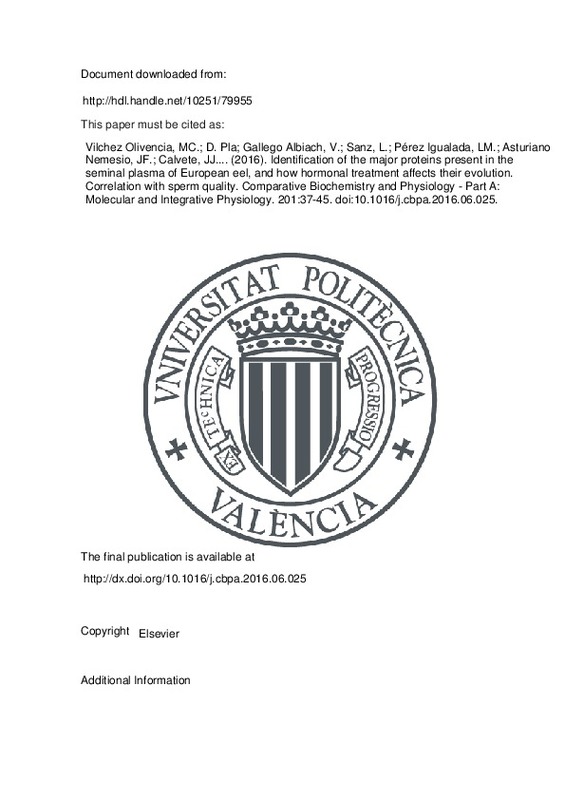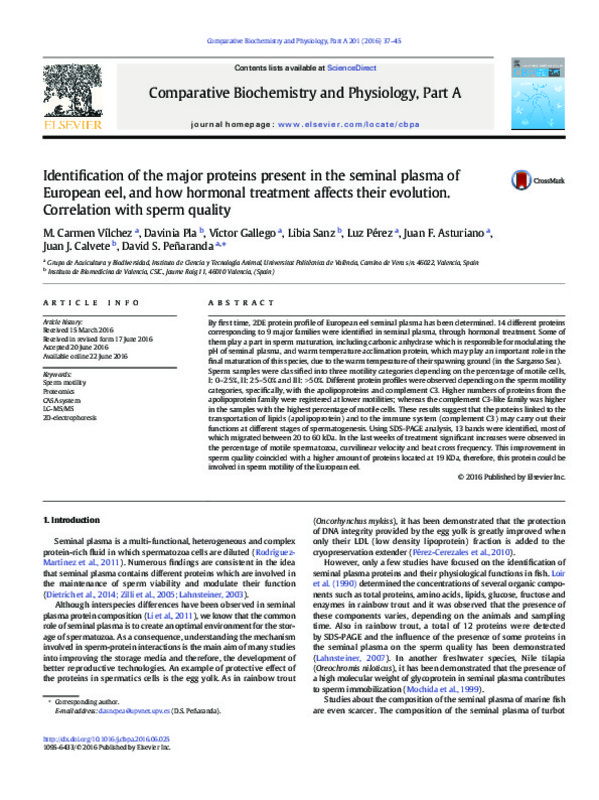JavaScript is disabled for your browser. Some features of this site may not work without it.
Buscar en RiuNet
Listar
Mi cuenta
Estadísticas
Ayuda RiuNet
Admin. UPV
Identification of the major proteins present in the seminal plasma of European eel, and how hormonal treatment affects their evolution. Correlation with sperm quality
Mostrar el registro sencillo del ítem
Ficheros en el ítem
| dc.contributor.author | Vilchez Olivencia, Maria Carmen
|
es_ES |
| dc.contributor.author | D. Pla
|
es_ES |
| dc.contributor.author | Gallego Albiach, Victor
|
es_ES |
| dc.contributor.author | Sanz, Libia
|
es_ES |
| dc.contributor.author | Pérez Igualada, Luz María
|
es_ES |
| dc.contributor.author | Asturiano Nemesio, Juan Francisco
|
es_ES |
| dc.contributor.author | Calvete, Juan J.
|
es_ES |
| dc.contributor.author | Peñaranda, D.S.
|
es_ES |
| dc.date.accessioned | 2017-04-25T16:31:07Z | |
| dc.date.available | 2017-04-25T16:31:07Z | |
| dc.date.issued | 2016-11 | |
| dc.identifier.issn | 1095-6433 | |
| dc.identifier.uri | http://hdl.handle.net/10251/79955 | |
| dc.description.abstract | [EN] By first time, 2DE protein profile of European eel seminal plasma has been determined. 14 different proteins corresponding to 9 major families were identified in seminal plasma, through hormonal treatment. Some of them play a part in sperm maturation, including carbonic anhydrase which is responsible for modulating the pH of seminal plasma, and warm temperature acclimation protein, which may play an important role in the final maturation of this species, due to the warm temperature of their spawning ground (in the Sargasso Sea). Sperm samples were classified into three motility categories depending on the percentage of motile cells, I: 0-25%, II: 25-50% and 111: >50%. Different protein profiles were observed depending on the sperm motility categories, specifically, with the apolipoproteins and complement C3. Higher numbers of proteins from the apolipoprotein family were registered at lower motilities; whereas the complement C3-like family was higher in the samples with the highest percentage of motile cells. These results suggest that the proteins linked to the transportation of lipids (apolipoprotein) and to the immune system (complement C3) may carry out their functions at different stages of spermatogenesis. Using SDS-PAGE analysis, 13 bands were identified, most of which migrated between 20 to 60 kDa. In the last weeks of treatment significant increases were observed in the percentage of motile spermatozoa, curvilinear velocity and beat cross frequency. This improvement in sperm quality coincided with a higher amount of proteins located at 19 KDa, therefore, this protein could be involved in sperm motility of the European eel. (C) 2016 Published by Elsevier Inc. | es_ES |
| dc.description.sponsorship | Funded from the REPRO-TEMP project (Spanish Ministry of Science and Innovation, MICINN; AGL2013-41646-R). and COST Office (COST Action FA1205: AQUAGAMETE). M.C.V. and V.G. have pre- and post-doctoral grants from UPV PAID Programme (2011-S2-02-6521 and 10-14 respectively). Valenciana de Acuicultura, S.A. (Puzol, Spain) supplied the eels used in this study. | en_EN |
| dc.language | Inglés | es_ES |
| dc.publisher | Elsevier | es_ES |
| dc.relation.ispartof | Comparative Biochemistry and Physiology - Part A: Molecular and Integrative Physiology | es_ES |
| dc.rights | Reconocimiento - No comercial - Sin obra derivada (by-nc-nd) | es_ES |
| dc.subject | CASA system | es_ES |
| dc.subject | Proteomics | es_ES |
| dc.subject | Sperm motility | es_ES |
| dc.subject | LC MS/MS | es_ES |
| dc.subject | 2D-electrophoresis | es_ES |
| dc.subject.classification | BIOLOGIA ANIMAL | es_ES |
| dc.subject.classification | PRODUCCION ANIMAL | es_ES |
| dc.title | Identification of the major proteins present in the seminal plasma of European eel, and how hormonal treatment affects their evolution. Correlation with sperm quality | es_ES |
| dc.type | Artículo | es_ES |
| dc.identifier.doi | 10.1016/j.cbpa.2016.06.025 | |
| dc.relation.projectID | info:eu-repo/grantAgreement/MINECO//AGL2013-41646-R/ES/LA ANGUILA EUROPEA COMO MODELO PARA ESTUDIAR LA TEMPERATURA COMO MODULADOR DE LA MADURACION SEXUAL EN TELEOSTEOS. POTENCIAL APLICACION EN ACUICULTURA/ | es_ES |
| dc.relation.projectID | info:eu-repo/grantAgreement/COST//FA1205/EU/Assessing and improving the quality of aquatic animal gametes to enhance aquatic resources - The need to harmonize and standardize evolving methodologies, and improve transfer from academia to industry/ | es_ES |
| dc.rights.accessRights | Abierto | es_ES |
| dc.contributor.affiliation | Universitat Politècnica de València. Instituto de Ciencia y Tecnología Animal - Institut de Ciència i Tecnologia Animal | es_ES |
| dc.contributor.affiliation | Universitat Politècnica de València. Escuela Técnica Superior de Ingeniería Agronómica y del Medio Natural - Escola Tècnica Superior d'Enginyeria Agronòmica i del Medi Natural | es_ES |
| dc.description.bibliographicCitation | Vilchez Olivencia, MC.; D. Pla; Gallego Albiach, V.; Sanz, L.; Pérez Igualada, LM.; Asturiano Nemesio, JF.; Calvete, JJ.... (2016). Identification of the major proteins present in the seminal plasma of European eel, and how hormonal treatment affects their evolution. Correlation with sperm quality. Comparative Biochemistry and Physiology - Part A: Molecular and Integrative Physiology. 201:37-45. https://doi.org/10.1016/j.cbpa.2016.06.025 | es_ES |
| dc.description.accrualMethod | S | es_ES |
| dc.relation.publisherversion | http://dx.doi.org/10.1016/j.cbpa.2016.06.025 | es_ES |
| dc.description.upvformatpinicio | 37 | es_ES |
| dc.description.upvformatpfin | 45 | es_ES |
| dc.type.version | info:eu-repo/semantics/publishedVersion | es_ES |
| dc.description.volume | 201 | es_ES |
| dc.relation.senia | 315452 | es_ES |
| dc.identifier.eissn | 1531-4332 | |
| dc.contributor.funder | European Cooperation in Science and Technology | es_ES |
| dc.contributor.funder | Ministerio de Economía y Competitividad | es_ES |
| dc.contributor.funder | Universitat Politècnica de València | es_ES |









